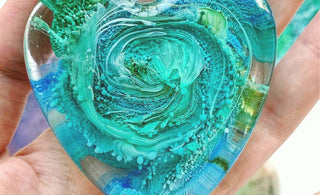When working with resin do not forget about protection of respiratory tract, skin and clothes!
- Use resin which has polymerization time of not more that 24 hours.
- Stir resin with hardener thoroughly to avoid defects on your product, stir slowly to avoid forming of excess air bubbles inside (if resin gets homogeneous transparent consistency you could pour it into the mold).
- Use only molds which are glossy inside to ensure that your product has a smooth transparent coating in the end.
- Pour the resin with a thin stream so that less air bubbles remain in the thickness of the resin.
- You can use an alcohol spray to remove air bubbles from the resin surface instead of a burner.
- It is required to work on a flat surface and cover it with shield material for keeping it safe.
- You can start working after the bubbles rise on the surface and you remove them!
- Select the required color palette from alcohol inks or special petri paints, shake the contents and turn off the caps for your convenience. Shake the white color well and start creating the patterns.
- After each drop of color use white! The white color drowns the colored paint creating effects in the thickness of the resin.
- Use special white paint for petri only with translucent bright shades! Only this paint has a composition that allows to make petri effects with these inks.
- Shake paint jars regularly before you make each drop to make the composition homogeneous!
- Do not drop the paint close to the silicone shaped sides as it prevents it from falling into the resin thickness.
- At the end you can move a toothpick in the resin to create the patterns.
- If the resin is too liquid wait for 20-30 minutes and then start working with the paint. This will make the viscosity higher and paint won’t fall too much to the bottom. The more liquid the resin is, the more chance that paint will fall to the bottom!
- Use resin which has polymerization time of not more that 24 hours.
- Stir resin with hardener thoroughly to avoid defects on your product, stir slowly to avoid forming of excess air bubbles inside (if resin gets homogeneous transparent consistency you could pour it into the mold).
- Use only molds which are glossy inside to ensure that your product has a smooth transparent coating in the end.
- Pour the resin with a thin stream so that less air bubbles remain in the thickness of the resin.
- You can use an alcohol spray to remove air bubbles from the resin surface instead of a burner.
- It is required to work on a flat surface and cover it with shield material for keeping it safe.
- You can start working after the bubbles rise on the surface and you remove them!
- Select the required color palette from alcohol inks or special petri paints, shake the contents and turn off the caps for your convenience. Shake the white color well and start creating the patterns.
- After each drop of color use white! The white color drowns the colored paint creating effects in the thickness of the resin.
- Use special white paint for petri only with translucent bright shades! Only this paint has a composition that allows to make petri effects with these inks.
- Shake paint jars regularly before you make each drop to make the composition homogeneous!
- Do not drop the paint close to the silicone shaped sides as it prevents it from falling into the resin thickness.
- At the end you can move a toothpick in the resin to create the patterns.
- If the resin is too liquid wait for 20-30 minutes and then start working with the paint. This will make the viscosity higher and paint won’t fall too much to the bottom. The more liquid the resin is, the more chance that paint will fall to the bottom!
